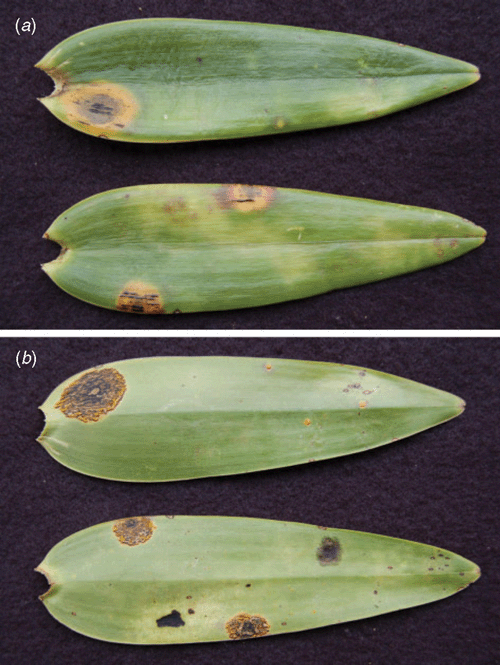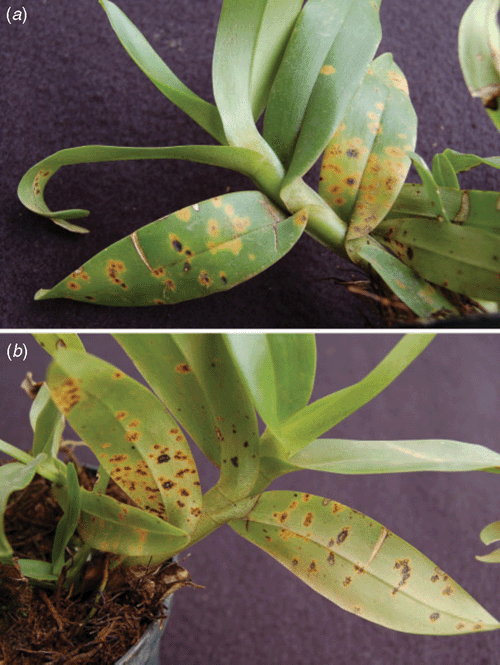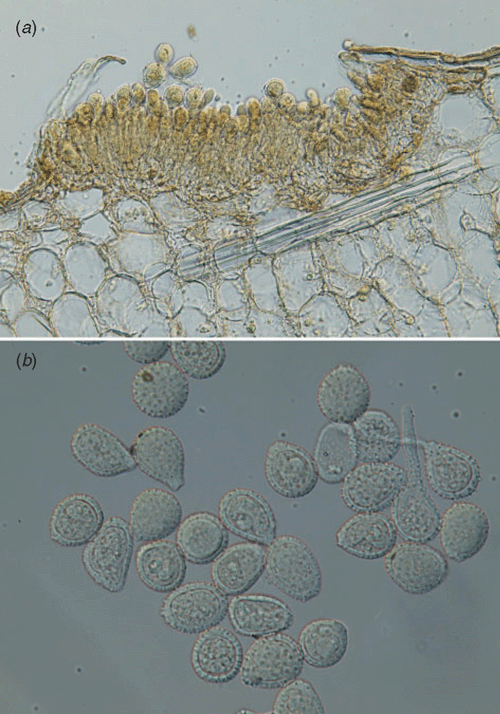Two new hosts, Epidendrum secundum and Epidendrum xanthinum, for the orchid rust Sphenospora kevorkianii (Raveneliaceae) in Brazil
O. L. Pereira A B and M. Silva AA Departamento de Fitopatologia, Universidade Federal de Viçosa, 36570-000 Viçosa, M.G., Brazil.
B Corresponding author. Email: oliparini@ufv.br
Australasian Plant Disease Notes 4(1) 62-63 https://doi.org/10.1071/DN09026
Submitted: 21 May 2009 Accepted: 25 May 2009 Published: 10 June 2009
Abstract
The rust Sphenospora kevorkianii, is reported on two new orchid hosts, Epidendrum secundum and Epidendrum xanthinum, in the state of Minas Gerais, Brazil.
Epidendrum secundum is an orchid with either an epiphytical or terrestrial habitat, characteristic of the Brazilian campos rupestres (montane grassland savanna). Epidendrum xanthinum is an epiphytic species characteristic of the Brazilian Atlantic rainforest. Both species are propagated by many Brazilian orchid growers, especially E. secundum for its cut flowers. In 2006, an exploratory project to survey and describe the phytopathogenic fungi associated with the family Orchidaceae in the state of Minas Gerais, Brazil was initiated (Silva and Pereira 2007, 2008; Silva et al. 2008). During this survey in the campos rupestres of Carrancas city and on a commercial orchid nursery in Araponga city, samples of the rust-infected orchids E. secundum and E. xanthinum were collected. Leaf lesions were yellowish to orange-brown, covered in powdery spore masses and coloured oil droplets, surrounded by circular chlorotic haloes and amphigenous (Figs 1, 2).

|

|
Morphological features of the fungus were: uredinia on lower leaf surfaces, subepidermal, erumpent, 200–550 × 120–300 µm; urediniospores ovoid, 25–35 × 16–25 µm, cell wall 2.0–4.5 µm thick, germ pore indistinct, hyaline becoming pale yellowish with abundant coloured oil dropets (Fig. 3). Spermogonia, aecia and telia not observed. Material examined: VIC 30693, on leaves of Epidendrum secundum, Cachoeira da Esmeralda, Carrancas, state of Minas Gerais, Brazil, O.L. Pereira, 10 Apr. 2008; VIC 30694, on leaves of Epidendrum xanthinum, Araponga, state of Minas Gerais, Brazil, O.L. Pereira, 15 Jun. 2008. Based on these characteristics the fungus was identified as Sphenospora kevorkianii.

|
Sphenospora kevorkianii is a rust fungus which was first reported from the orchid Epidendrum difforme in Nicaragua (Linder 1944). In Brazil, this rust has been reported on Catasetum sp., Catasetum fimbriatum, Catasetum maranhense, Cyrtopodium sp., Cyrtopodium punctatum, Epidendrum sp., Notylia lyrata, Plelurothallis mentigera, Prescottia sclerophylla, Sauroglossum nitidum, Spiranthes sp., Stanhopea graveolens, Stenorrhynchus sp. and Zygostates lunata (Pereira et al. 2002; Pereira and Barreto 2004; Hennen et al. 2005; Silva and Figueiredo 2006).
This is the first report of S. kevorkianii attacking E. secundum and E. xanthinum in Brazil.
Acknowledgements
We are grateful to Fundação de Amparo à Pesquisa do Estado de Minas Gerais-FAPEMIG for providing financial support (project 279/07) and O. L. Pereira acknowledges the Conselho Nacional de Desenvolvimento Científico e Tecnológico-CNPq research fellowship of this ongoing program to survey and describe the phytopathogenic and the endophytic mycodiversity associated with the family Orchidaceae in the state of Minas Gerais.
Linder DH
(1944) A new rust of orchids. Mycologia 36, 464–468.
| Crossref | GoogleScholarGoogle Scholar |

Pereira OL, Barreto RW
(2004) First report of Sphenospora kevorkianii (Raveneliaceae) on the orchid Catasetum fimbriatum in Brazil. Plant Pathology 53, 256.
| Crossref | GoogleScholarGoogle Scholar |

Pereira OL,
Cavallazzi JRP,
Rollemberg CL, Kasuya MCM
(2002)
Sphenospora kevorkianii, a rust fungus (Uredinales: Raveneliaceae) on the orchid Pleurothallis mentigera. Brazilian Journal of Microbiology 33, 155–156.
| Crossref | GoogleScholarGoogle Scholar |

Silva GS, Figueiredo MB
(2006)
Catasetum maranhense, um novo hospedeiro de Sphenospora kevorkianii (Uredinales). Summa Phytopathologica 32, 197.
| Crossref | GoogleScholarGoogle Scholar |

Silva M, Pereira OL
(2007) First report of Guignardia endophyllicola leaf blight on Cymbidium (Orchidaceae) in Brazil. Australasian Plant Disease Notes 2, 31–32.
| Crossref | GoogleScholarGoogle Scholar |

Silva M, Pereira OL
(2008) Black mildew disease of the neotropical orchid Epidendrum secundum caused by Lembosia epidendri sp. nov. from Minas Gerais, Brazil. Mycotaxon 104, 385–390.

Silva M,
Pereira OL,
Braga IF, Lelis SM
(2008) Leaf and pseudobulb diseases on Bifrenaria harrisoniae (Orchidaceae) caused by Phyllosticta capitalensis in Brazil. Australasian Plant Disease Notes 3, 53–56.



